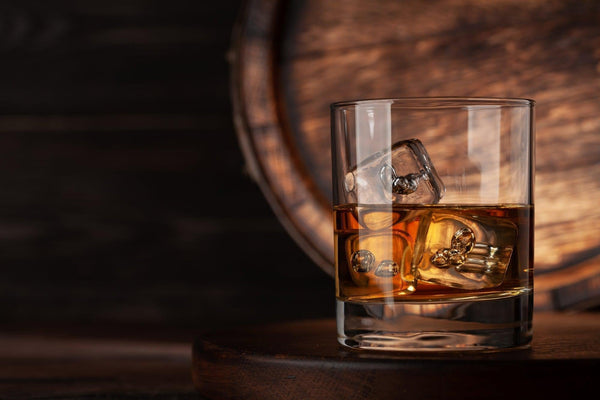
Jump to:
Although still ranking behind beer, nihonshu (popularly known as “sake”), and shochu in terms of consumption, the market share of Japanese whiskey has been steadily increasing over time. Japanese whiskey has regularly won international awards.
In 2015, the Yamazaki Single Malt Sherry Cask 2013 was named the best whiskey in the world by Jim Murray’s Whisky Bible, an influential annual publication that reviews thousands of whiskeys from around the world. Indeed, global demand for Japanese whiskey has soared.
In this post, we explore its history, key brands, unique features, and where to buy Japanese whiskey.
The History Of Japanese Whiskey

Imported whiskey was introduced to Japan during the Meiji Restoration, but due to its hefty price tag, it was mainly enjoyed only by expatriates and Japanese elites with an interest in Western culture.
This all changed in the early twentieth century, however, when Masataka Taketsuru from the company Kotobukiya (later to be renamed “Suntory” in 1963) traveled to Scotland to learn the art of whiskey-making, where he apprenticed at some local distilleries.
Following that, in 1923, Shinjiro Torii, one of the founders of the company, established the Yamazaki distillery near Kyoto, the first of its kind in Japan, and hired Taketsuru as an executive of the distillery.
After the Second World War, Suntory and Nikka emerged as the two main players as Japanese whiskey began to grow in popularity. With the popularity of drinks like the “highball,” in which whiskey is mixed with soda, whiskey began to become more integrated into Japanese culture.
Moving into the twentieth century, it picked up more and more awards overseas, leading to a global boom in Japanese exports and this has caused a lack of some aged varieties in Japan and resulted in price spikes.
Distinguishing Features Of Japanese Whiskey

As already discussed, Masataka Taketsuru studied whiskey-making in Scotland, so it is only natural that the initial offerings of Japanese whiskey mirrored the methods of scotch in terms of the use of pot stills, traditional mashing, fermentation, and the distillation process. However, since that time, Japanese whiskey, while still closely resembling scotch, has developed its own distinctive characteristics.
The distinguishing features of Japanese whiskey include the fact that, although like scotch it is primarily made from malted barley, it also blends other grains and Japanese distilleries are very inventive, trying different blending techniques and cask types to give them original flavors.
Whereas scotch is always aged in oak casks, Japanese whiskey may use American oak, sherry casks, as well as Mizunara oak, and this imparts distinctive elements into the whiskey.
Further, as is generally the case with Japanese craftsmanship, the whiskey makers are very precise in their craft and this tends to make for a smoother product.
Last but not least, the varied nature of the Japanese climate, which combines steaming hot summers and bitterly cold winters, speeds the aging process leading to distinct maturation differences compared to scotch whiskey.
In a nutshell:
- Primarily made from malted barley, but often blended with other grains for unique flavors.
- Innovative blending techniques and varied cask types to create original taste profiles.
- Uses a variety of casks, including American oak, sherry casks, and Mizunara oak, imparting distinctive flavors.
- Exceptional precision and craftsmanship, resulting in a smoother product.
- Maturation influenced by Japan’s varied climate, with hot summers and cold winters speeding the aging process and creating unique characteristics.
Best Japanese Whiskey Brands

When it comes to large-scale producers of Japanese whiskey, three names stand out: Suntory, Nikka, and Kirin. Kirin, though better known for beer, also makes whiskey at its Fuji Gotemba distillery at the foot of Mt. Fuji.
Here’s a breakdown of the famous brands from these major players:
Suntory Whiskey
- Yamazaki: A single malt with complex fruity flavors.
- Hakushu: Light, fresh, herbal, and slightly peaty (aged in American oak).
- Hibiki: A blended whiskey that’s smooth, floral, and layered, thanks to aging in different types of casks like American oak, sherry, and Mizunara oak.
Nikka Whiskey
- Yoichi: Smoky and peaty, similar to traditional Scotch.
- Miyagikyo: Light, elegant, fruity, and delicate.
- Nikka From the Barrel: Rich, full-bodied, and complex, blending single malts and grain whiskeys.
- Coffey: Sweet and smooth, with options like Coffey Grain and Coffey Malt.
Kirin Whiskey (Fuji Distillery)
- Single Grain Whiskey: Made mainly from corn; smooth and sweet with vanilla, caramel, or fruity notes.
- Single Malt Whiskey: Made from malted barley; richer with a slightly smoky flavor.
Boutique Japanese Whiskey Brands

Smaller boutique producers like Chichibu, Karuizawa, Eigashima, and Mars Whiskey may not have the size or budget of the big distilleries, but they’ve added unique flavors and creativity to the Japanese whiskey scene.
Chichibu Whiskey
Made in small batches with careful craftsmanship.
- Chichibu The First: Rich, malty, fruity, and spicy.
- Chichibu The Peated: Sweeter fruitiness with a smoky, peaty flavor.
Karuizawa Distillery
Closed in 2000, but its whiskeys remain extremely rare and sought-after.
- Karuizawa 1960: Complex, sherry-like taste with a velvety finish.
- Geisha Series: Dark, rich, with floral notes.
- Noh Series: Smokier with sherry-influenced flavors.
Eigashima (White Oak) Distillery
Located in Akashi, Hyogo Prefecture, producing:
- Akashi Blended: Light and easy for casual drinking.
- Akashi White Oak: Complex with malt and fruity notes.
- Akashi Single Malt: Aged in bourbon, sherry, and virgin oak casks, giving it a refined, elegant character.
Mars Whiskey
Produced at the high-altitude Mars Shinshu Distillery in Nagano, using pure water and the unique climate.
- Komagatake: Fruity and spicy, aged in bourbon and sherry casks.
- Iwai: Inspired by American bourbon; smoky with soft caramel and vanilla notes.
- Cosmo: Another popular offering (details often highlighted by the distillery).
Japanese Whiskey Vs Other Types Of Whiskey And Bourbon

Japanese whiskey takes inspiration from Scotch but has developed its own unique style. It is generally lighter, more delicate, and features floral and fruity notes.
Japan’s climate also speeds up the aging process, giving Japanese whiskey a refined taste faster than some other whiskeys.
Compared to other types of whiskeys:
|
Whiskey Type |
Origin / Method |
Flavor Profile |
Key Notes / Ingredients |
|---|---|---|---|
|
Japanese Whiskey |
Inspired by Scotch, uses malted barley & other grains, aged in various barrels including Mizunara oak |
Light, delicate, floral, fruity, subtle smoke |
Nuanced, elegant, complex |
|
Scotch |
Traditional Scottish methods, malted barley, pot stills, oak casks |
Smoky, peaty (varies by region) |
Diverse flavors depending on region |
|
Irish Whiskey |
Triple distilled, mostly barley, oak casks |
Smooth, light, sweet, slightly fruity |
Approachable and easy to drink |
|
Bourbon |
Primarily corn, aged in new charred oak barrels |
Rich, full-bodied, sweet |
Notes of caramel, vanilla, oak |
Best Japanese Whiskey For Beginners
Japanese whiskey is smooth, delicate, and approachable, making it ideal for those new to whiskey. Its floral, fruity, and lightly smoky flavors are easy to enjoy neat, on the rocks, or in a highball.
- Hibiki Japanese Harmony
A perfect beginner-friendly option. It offers light, floral notes with hints of honey and orange peel. Smooth and easy to sip, it blends beautifully in cocktails and provides a gentle introduction to Japanese whiskey without overwhelming the palate.
2. Yamazaki 12-Year-Old
Also from Suntory, is a classic single malt that appeals to newcomers with its fruity flavor, subtle oak, and delicate smokiness. Its approachable complexity makes it a favorite for beginners who want to explore a single malt Japanese whiskey.
3. Hakushu Distiller’s Reserve
Another Suntory offering, is fresh and herbal with a lightly peaty character. Crisp and refreshing, it’s ideal for beginners seeking a lighter, more invigorating whiskey experience that’s easy to enjoy on its own or in a highball.
4. Nikka From the Barrel
A rich and full-bodied, blending single malts and grain whiskey to create a balanced and slightly spicy profile. While more complex, it remains smooth and approachable, making it a great introduction for beginners who want to experience a fuller-bodied Japanese whiskey.
5. Yoichi Single Malt
For those curious about smokier flavors, this single malt from Nikka offers gentle smokiness with fruity undertones. It’s an excellent way for beginners to explore a lightly peated Japanese whiskey without the intensity of traditional Scotch.
How to Drink Japanese Whiskey
When enjoying Japanese whiskey as a beginner, there are several ways to experience it. Sipping neat allows you to savor subtle flavors, while adding ice can soften the alcohol and make it more approachable.
A highball, made with one part whiskey and three parts soda over ice, offers a refreshing and light introduction.
Japanese whiskey also works well in classic cocktails like the Old Fashioned or Whiskey Sour, and beginners can experiment with pairing it with mild foods such as sushi, grilled chicken, or soft cheeses to highlight its nuanced flavors.
For those starting out, it’s generally best to begin with blended whiskeys like Hibiki Harmony before exploring heavily peated or aged single malts.
Trying a whiskey flight at a bar is another great way to compare different bottles and learn which flavors you enjoy most.
Ways to Enjoy Japanese Whiskey

Japanese whiskey can be enjoyed in many ways beyond the usual neat or on the rocks:
- Oyuwari & Mizuwari: Whiskey mixed with hot water (Oyuwari) or cold water (Mizuwari).
- Highball: Whiskey mixed with soda water over ice, usually 1 part whiskey to 3 parts soda. Light and bubbly, perfect for casual drinking or pairing with food.
- Whiskey Cocktails: Classics like Old Fashioned or Manhattan are popular, often with Japanese twists using ingredients like Yuzu, Shiso, Matcha, or Wasabi.
- Infusions: Some bars experiment with fruits, spices, or herbs for unique flavors.
- Whiskey Flights: Sampling several whiskeys in small pours to compare flavors and aromas.
- Food Pairings: Enjoy whiskey with sushi, grilled meats, chocolates, or other dishes to enhance the tasting experience.
Good Places To Enjoy Japanese Whiskey

Japan has a wide range of places to enjoy Japanese whiskey, from casual spots to luxurious experiences.
- Specialty Whiskey Bars: Places like Apollo Ginza, Bar Highlander, and Rock Fish have large collections of Japanese and international whiskies, perfect for tasting in a cozy setting.
- High-End Hotels: Bars in hotels, like the “Scottish Bar” at Hotel Okura, offer rare and vintage whiskeys in a luxurious atmosphere.
- Casual Izakaya: For a relaxed, social vibe, izakaya serve whiskey highballs and are great for everyday drinking. Hidden gems like Cask Strength in Roppongi offer unique experiences.
- Whiskey Museums & Distilleries: Learn and taste at the Suntory Yamazaki Distillery or Nikka Whisky Yoichi Distillery.
- Whiskey Festivals: Events like the Osaka Whiskey Festival and Fukuoka Whiskey Festival are perfect for tasting multiple whiskeys at once.
- Cocktail Bars & Onsen Resorts: Enjoy innovative whiskey cocktails made by mixologists or sip whiskey while relaxing in a hot spring.
The Most Expensive Japanese Whiskeys

For whiskey lovers with deep pockets, some Japanese whiskeys are incredibly rare and pricey:
- Yamazaki 55-Year-Old Single Malt: Made by Suntory, blended from malts distilled in 1960 and 1964, aged in Mizunara and white oak casks. Price: just under 1 million yen.
- Yamazaki 50-Year-Old: Slightly cheaper, but still extremely valuable, with only 150 bottles ever made.
- Hanyu Ichiro’s Malt Card Series: A legendary set of 54 bottles, each representing a playing card, priced similarly to the Yamazaki 50-year-old.
- Karuizawa 1960: From the now-closed Karuizawa distillery, individual bottles have sold for over $300,000.
These whiskeys are prized for their rarity, craftsmanship, and unique flavors, making them highly sought after by collectors and connoisseurs.
The Enduring Legacy And Global Impact of Japanese Whiskey

Japanese whiskey has earned its place on the world stage thanks to its rich history, precise craftsmanship, and innovative use of casks like American oak, sherry, and Mizunara.
From major brands like Suntory, Nikka, and Kirin to boutique names like Chichibu, Eigashima, and Mars, there’s a flavor for every palate: fruity, floral, smoky, or peaty.
If you like Japanese alcohol, explore our top recommendations and find your new favorite drink


0 comments